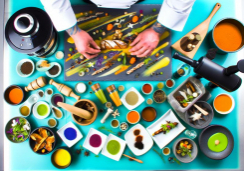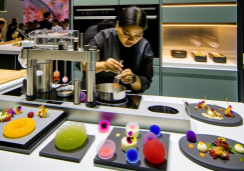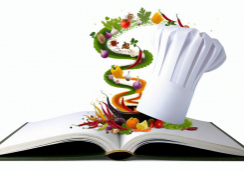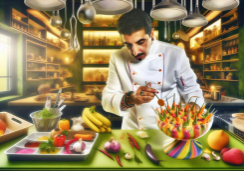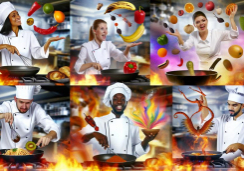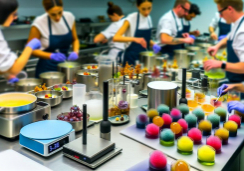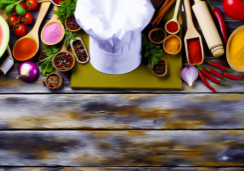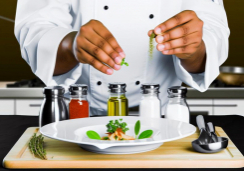Unleashing Creativity in Gluten-Free Baking Recipes
As you stand before your array of alternative flours, you might think that the secret to gluten-free baking is simply swapping out wheat flour for a magical all-purpose gluten-free blend—and poof, perfection. Yet, the reality is that unleashing creativity in gluten-free baking requires a bit more finesse. You've got to navigate the diverse landscape of rice, almond, and coconut flours, each with their quirks and charms.
Mastering the alchemy of gluten-free ingredients isn't just a useful skill—it's an art form that can lead to mouthwatering results. As you embark on this culinary journey, remember that patience and experimentation are your allies. You'll find that the right combination of these unconventional ingredients can produce textures and flavors that rival, or dare say, surpass traditional wheat-based counterparts.
Prepare to explore innovative techniques and uncover the secrets behind crafting delectable gluten-free treats that'll impress even the most skeptical of palates.
Exploring Alternative Flours
Dive into the world of alternative flours and discover how they can transform your gluten-free baking with exciting new flavors and textures. You're not just substituting; you're enhancing and expanding your culinary repertoire.
With flours like almond, coconut, and chickpea, you can introduce a spectrum of nuanced tastes and nutritional benefits to your gluten-free creations.
Almond flour brings a rich, buttery profile and helps create moist, dense baked goods. It's perfect for those who're looking to add protein and fiber to their diet without compromising on taste.
Coconut flour, on the other hand, infuses a light, tropical essence and is highly absorbent, making it ideal for creating tender textures.
Chickpea flour, a staple in many cultures, offers a savory note and is packed with protein and fiber. It's excellent for heartier dishes like gluten-free breads and pizza crusts.
Embrace these alternative flours and you'll find that gluten-free baking isn't just about avoiding gluten—it's about embracing a world where each flour opens the door to innovative, delectable treats. You're not just baking; you're on a journey to redefine the joy of creating and savoring wholesome, gluten-free treats.
Mastering Gluten-Free Techniques
As you explore the diverse flavors of alternative flours, it's equally important to sharpen your skills in gluten-free baking techniques to ensure every creation is as delightful in texture as it's in taste. Your culinary journey into gluten-free baking isn't just about swapping flours; it's a reimagining of traditional methods to celebrate the unique properties of your baking ingredients.
Precision is your best friend, and practice will be the guide that helps you navigate this innovative terrain.
Here are three techniques to master:
- Understand the interplay between wet and dry ingredients: Gluten-free baking often requires a different ratio of wet to dry ingredients to achieve the desired consistency.
- Leverage natural binders: Incorporate ingredients like xanthan gum, eggs, or flaxseeds to provide structure and moisture retention in the absence of gluten.
- Experiment with mixing methods: Some recipes may benefit from a gentle fold, while others might need vigorous beating to incorporate air and build structure.
Every triumph and mishap leads to a deeper understanding of your ingredients and how they interact. Embrace this innovative process with an open mind, and you'll find that precision and creativity are the keystones to unlocking the full potential of gluten-free baking.
Innovative Mixing and Baking
Venture beyond traditional baking by incorporating innovative mixing and baking techniques that cater to the distinctive nature of gluten-free ingredients. As you explore different gluten-free flour blends, you'll unlock unique flavor combinations and textures that'll elevate your culinary creations. From the nutty essence of almond flour to the earthy tones of sorghum, each ingredient brings its own character to your table.
Don't shy away from alternative binding agents like flaxseed meal or psyllium husk. These power players not only enhance the structure of your bread making endeavors but also ensure every bite is tender and satisfying. And when it comes to moisture and richness, think outside the box. Pureed fruits and vegetable purees can introduce a subtle sweetness or savory depth, while nut butters infuse your treats with a creamy indulgence.
In your quest for perfection, leverage the magic of natural thickeners and leavening agents. These essentials are the secret to achieving those desirable textures that are so challenging in gluten-free recipes. By embracing this creativity and innovation, you'll transform the way you think about gluten-free baking ingredients and techniques. The result? Delightfully diverse and nutrient-rich goodies that cater to all taste buds and dietary needs.
Flavor Enhancement Strategies
Building on the foundation of innovative mixing and baking techniques, it's essential to fine-tune the flavors in your gluten-free recipes using a variety of herbs, spices, and alternative sweeteners. By focusing on the intricate balance of flavors, you can transform your gluten-free baking from mundane to extraordinary. Culinary creativity isn't just about the blend of flours you choose; it's equally about the symphony of tastes you create.
Here are three key strategies to enhance the flavor profile of your gluten-free delights:
- Introduce Herbs and Spices: Amp up the taste by incorporating an array of herbs and spices. For instance, cinnamon can add warmth to sweet treats, while rosemary can imbue savory bread with a fragrant, earthy note.
- Alternative Sweeteners: Swap traditional sugar with natural sweeteners like honey, agave, or maple syrup. Not only do they impart unique flavors, but they also contribute to the moisture content, crucial for the texture of your wet ingredients.
- Umami Elements: Elevate savory baked goods by adding umami-rich ingredients such as tamari, miso, or nutritional yeast. These can provide a depth of flavor that traditional baking ingredients might lack in gluten-free recipes.
Designing Artful Presentations
Transform your gluten-free baked goods into visual masterpieces with techniques that ensure each creation is as pleasing to the eye as it's to the palate. By mastering the art of presentation, you elevate not only the flavors within your culinary creations but also the overall experience of enjoying them. The secret lies in the thoughtful arrangement and selection of ingredients that complement each other in color, texture, and form.
When you're baking, consider the final plating as an integral part of the process. Select dishes and utensils that will showcase your gluten-free treats effectively. A contrasting plate can make your baked goods pop, while a minimalist approach can underscore their natural beauty. Remember, the way you present your food can tell a story about your dedication and creativity in the kitchen.
Incorporate edible flowers, a sprinkle of colorful spices, or a drizzle of vibrant sauce to make your dishes not only delicious but visually stunning. With every ingredient you choose, ask yourself how it contributes to the overall aesthetic.
Conclusion
Now you've got the tools to excel in gluten-free baking! Embrace the diverse flours at your fingertips, perfect your techniques, and experiment with mixing and baking methods.
Enhance flavors boldly, and present your creations with artistry. Your kitchen's now a canvas for innovation, and with each bake, you're not just making food—you're crafting experiences.
Go ahead, show the world that gluten-free isn't just an alternative; it's a pathway to culinary brilliance.
Keep creating, keep enjoying!

